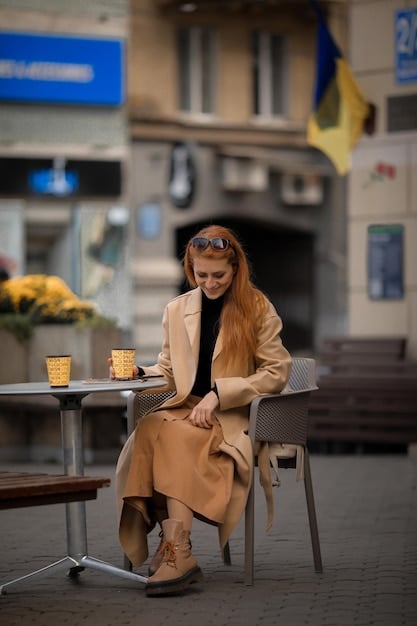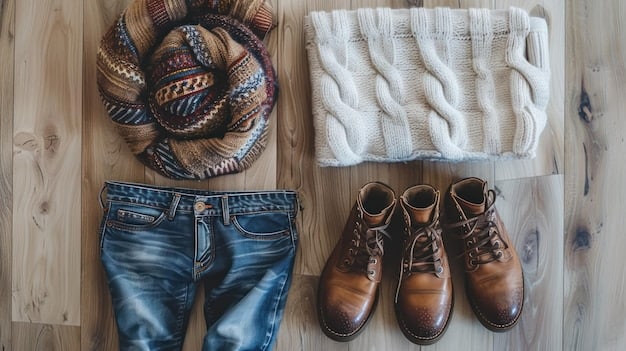Master Layering: Warm & Fashionable Outfits for Any Season

Anúncios
Layering involves strategically combining clothing items to create versatile, comfortable, and stylish outfits suitable for varying temperatures and occasions, offering both warmth and a personalized aesthetic adaptable to any season.
In the dynamic world of fashion, few techniques offer the blend of practicality and panache quite like layering. It’s more than just piling on clothes; it’s an art form that allows you to transform simple garments into sophisticated ensembles, adapting to unpredictable weather while expressing your unique style. Mastering the art of layering: Build warm and fashionable outfits for any season empowers you to navigate temperature fluctuations with grace, ensuring comfort without compromising on elegance.
The foundational principles of effective layering
Effective layering begins with understanding core principles that govern both aesthetics and functionality. It’s about building an outfit from the ground up, considering each piece’s role in insulation, texture, and visual appeal. The goal is to create coherent looks that are easy to adjust throughout the day.
The first principle is the “base, middle, outer” layer approach. The base layer is closest to your skin, typically thin and breathable, designed to wick moisture away. The middle layer provides insulation, trapping warmth. Finally, the outer layer protects against elements like wind and rain. Fabric choice plays a pivotal role here, as different materials offer varying degrees of warmth and breathability, allowing for adaptable comfort across climates.
Understanding fabric types for layering
Selecting the right fabrics is crucial for successful layering. Natural fibers like wool and cotton offer breathability, while synthetics like polyester and fleece excel in moisture-wicking and insulation. Blending these materials can provide the best of both worlds, offering warmth without bulk.
- Natural Fibers: Wool (merino for warmth without itch), cotton (breathable, good for base layers in milder weather), silk (luxurious, adds a thin layer of warmth).
- Synthetic Fibers: Polyester (excellent moisture-wicking, quick-drying), fleece (highly insulating, lightweight), nylon (water-resistant, durable).
Consider the texture and drape of each fabric. A smooth silk camisole pairs well under a chunky knit sweater, for instance, creating visual interest and preventing bulk. Similarly, a lightweight denim shirt can be layered over a t-shirt and under a blazer, adding a casual yet refined dimension.
The second principle involves proportionality and silhouette. Over-layering can lead to a bulky, shapeless look. Instead, focus on creating varying lengths and volumes. A longer tunic under a shorter sweater, or a fitted base layer beneath a relaxed-fit jacket, can add visual depth. This thoughtful consideration of fit and form ensures that each layer contributes to a flattering overall silhouette, rather than detracting from it.
Finally, color and pattern coordination elevate a layered outfit from functional to fashionable. While monochromatic layering can be chic, don’t shy away from incorporating complementary colors or subtle patterns. A patterned scarf or a textured cardigan can introduce visual interest without overwhelming the look. The key is balance; one statement piece can often anchor an entire layered ensemble, allowing other elements to be more subdued.
Seasonal layering strategies: From brisk mornings to warm afternoons
The beauty of layering lies in its adaptability. Each season presents unique challenges and opportunities for building stylish, comfortable outfits. Understanding how to adapt your layering strategy to different climates is key to year-round fashion success.
Spring: Transitional layering for unpredictable weather
Spring is perhaps the most challenging season for dressing, characterized by unpredictable temperature swings. Light layers are your best friends. Think breathable blouses, thin cardigans, light denim jackets, and trench coats. The aim is to have pieces that can be easily added or removed as the day progresses from cool mornings to warmer afternoons.
A classic spring layered look might involve a short-sleeved t-shirt as a base, a chambray shirt unbuttoned over it, and a lightweight bomber jacket or trench coat on top. Pairing these with versatile bottoms like straight-leg jeans or chinos ensures readiness for varied spring escapades, from café visits to park strolls. The emphasis is on versatility and ease of transition.
Accessories also play a greater role in spring. A light scarf can offer warmth on cooler breezes and be easily stowed away when the sun emerges. Closed-toe flats or ankle boots work well for morning chills, while open-toe options become viable as the day warms up. This dynamic approach allows for comfort and style, regardless of the fleeting spring weather.

Summer: Strategic layering for cool evenings
Layering in summer might seem counterintuitive, but it’s essential for air-conditioned environments, cooler evenings, or protecting skin from the sun. The focus shifts to extremely lightweight, breathable fabrics. Linen, cotton, and sheer materials become paramount.
- Evening Chill: A light denim jacket, a linen blazer, or a pashmina can be draped over shoulders.
- Sun Protection: Lightweight, long-sleeved shirts in breathable fabrics like linen or sheer cotton can protect from sun while remaining cool.
- Air-Conditioned Spaces: A simple cardigan or a classic button-down shirt (worn open) can be a savior indoors.
Consider the “third piece” rule even in summer: how a vest, a kimono, or an unbuttoned shirt can complete an outfit. For instance, a flowy maxi dress can be elevated with a denim vest, providing a subtle layer. This strategic layering ensures comfort and stylish versatility without adding unnecessary bulk or heat, making summer layering an art of subtle additions.
Autumn: The golden age of layering
Autumn is where layering truly shines. The crisp air and vibrant colors invite richer textures and more substantial pieces. This season offers the perfect opportunity to experiment with various fabrics, from chunky knits to leather and tweed.
Begin with a long-sleeved tee or a thin turtleneck as your base. Layer a cozy flannel shirt or a cashmere sweater over it. For the outer layer, opt for a stylish blazer, a utility jacket, or a classic wool coat. The blend of textures and volumes creates visually appealing depth. This is also the season for integrating vests, both quilted and knit, for added warmth and style, creating dynamic silhouettes that move and play with light.
Autumn layering also extends to accessories. Statement scarves, fedora hats, and leather gloves not only provide warmth but also serve as key stylistic elements. Footwear shifts to ankle boots, tall boots, and loafers, complementing the richer textures of the clothing. The opportunity to play with color palettes, from earthy tones to deep jewel hues, further enhances the autumn layering experience, making each outfit a thoughtful composition.
Winter: Maximum warmth, maximum style
Winter layering is all about warmth, but without sacrificing style. This means strategic use of insulating materials and clever combinations. The base layer should be thermal, designed to wick moisture. Mid-layers can include chunky sweaters, fleece jackets, or even down vests. The outer layer is critical: a high-quality wool coat, a puffer jacket, or a parka. These provide the ultimate protection against the cold.
The goal is to trap air between layers, which enhances insulation. Don’t be afraid to mix and match different weights and textures. For example, a fine-gauge merino wool base can go under a thick cable-knit sweater, which then goes under a stylish peacoat. This creates a cozy cocoon while offering visual interest through varied textures. Pay attention to fit; ensure layers aren’t too tight, which can restrict blood flow and reduce warmth.
Winter accessories become functional fashion statements. Oversized scarves, knit beanies, and insulated gloves are not just practical but add personality and color to an otherwise muted winter palette. Thermal socks and waterproof boots are non-negotiable for staying warm and dry. Smart winter layering transforms the challenge of cold weather into an opportunity for sophisticated, comfort-driven fashion, demonstrating that warmth and style can indeed coexist harmoniously.
The art of balancing layers: Proportions and silhouettes
Mastering layering involves more than just stacking clothes; it’s about understanding how to balance proportions and create flattering silhouettes. Without this consideration, layered outfits can appear bulky or shapeless, defeating the purpose of elevating your style. The key lies in strategic garment selection and thoughtful combination.
One fundamental aspect is playing with length. Layering longer pieces under shorter ones can create an intriguing visual effect and add a modern appeal to your outfit. For example, a longline t-shirt or tunic peeking out from under a cropped sweater, or a midi dress worn beneath a shorter jacket, elongates the silhouette and adds an element of surprise. This technique prevents the outfit from looking flat and adds dynamic flow, guiding the eye beautifully.
Volume and fit: Creating visual interest
Varying the volume and fit of your layers is another crucial technique. Start with a fitted or semi-fitted base layer, then add a slightly looser middle layer, and finish with a structured or oversized outer layer. This progression in volume creates an appealing visual taper or contrast, preventing a boxy appearance. Conversely, a fitted outer layer over looser internal pieces can also provide a sleek and contained look.
- Fitted to Loose: A slim-fit turtleneck under a relaxed-fit knit, topped with an oversized blazer.
- Contrasting Silhouettes: A voluminous peasant blouse under a tailored vest, or a fitted sweater dress paired with a cocoon coat.
Consider the fabric’s drape and how it contributes to the overall silhouette. Stiff fabrics add structure, while fluid ones create softness and movement. Combining a structured denim jacket with a soft, flowing dress demonstrates this balance effectively. Additionally, pay attention to necklines and hemlines; these details can define the shape of your layered look and add subtle points of interest.
The rule of thirds can also be applied to layering, where an outfit is divided into dominant and subordinate sections, creating a visually pleasing proportion. For instance, a top that makes up one-third of the visible outfit, while the bottom forms the remaining two-thirds, often looks balanced. This aesthetic principle helps ensure that your layered ensemble feels harmonious and deliberately constructed, rather than haphazardly thrown together.
Ultimately, the goal is to create depth and dimension without adding unnecessary bulk. Experiment with different combinations, step back, and observe how the proportions work together. Sometimes, simply rolling up sleeves or tucking in a shirt can dramatically alter the feel and silhouette of a layered look, demonstrating the power of small adjustments in achieving a balanced and fashionable ensemble.
Accessorizing your layered ensembles: Beyond the basics
Accessories are not mere afterthoughts; they are integral to a successful layered outfit, serving both functional and aesthetic purposes. They can add pops of color, introduce new textures, or simply provide an extra layer of warmth, completing the narrative of your ensemble. Thoughtful accessorizing elevates a good outfit to a great one, showcasing attention to detail and personal style.
Scarves are arguably the most versatile layering accessory. From lightweight silk squares that add a touch of elegance to chunky knit infinity scarves that provide substantial warmth, they can transform a simple base layer into a focal point. Experiment with different tying techniques – a simple knot, a Parisian knot, or draped loosely – to vary the visual impact. A scarf can also introduce a patterned element to an otherwise solid-colored outfit, breaking monotony and adding dynamic flair.
Belts: Defining your waistline and adding polish
Belts are essential for defining your waistline amidst multiple layers, preventing a bulky or shapeless appearance. A wide belt cinched over a chunky cardigan or a long tunic can create an hourglass silhouette. A thinner belt can similarly be used over a midi dress layered with a blazer, adding structure and polish.
- Styling a Belt: Cinch over sweaters, cardigans, or even lightweight coats to define the waist.
- Material and Buckle: Choose a belt that complements the textures and colors of your layered outfit, from minimalist leather to bold metallic buckles.
Beyond functionality, a belt can add a distinct style element. A statement buckle or an interesting texture can draw the eye and provide a focal point, grounding the layered look. This deliberate use of a belt ensures that your shape remains visible and celebrated, even under multiple garments, affirming your personal aesthetic.
Hats, gloves, and jewelry also play significant roles. A stylish beanie or a wide-brimmed hat can provide warmth while adding character. Gloves, whether sleek leather or cozy knit, add a sophisticated or playful touch. Jewelry, particularly statement necklaces or stacked bracelets, can provide a shimmer that peeks through layers, adding a subtle touch of glamour. These smaller elements coalesce to create a cohesive and well-rounded layered appearance.
Ultimately, accessories should complement rather than compete with your layered attire. They are the final touches that personalize your look, offering opportunities for self-expression. By thoughtfully integrating scarves, belts, hats, and jewelry, you can elevate your layering game, ensuring that every detail contributes to a fashionable and functional ensemble, transforming practicality into sophisticated flair.
Overcoming common layering challenges
While layering offers immense stylistic possibilities, it’s not without its challenges. Common pitfalls include looking bulky, feeling overheated, or misjudging transitions between different temperatures. However, with a few strategic insights, these hurdles can be easily overcome, turning potential problems into opportunities for refined style.
One of the most frequent concerns is the “Michelin Man” effect—looking too puffy or shapeless. This often arises from using overly thick fabrics for every layer or neglecting proper fit. To avoid this, prioritize thin, breathable base layers and gradually build up with slightly thicker, but not necessarily bulky, middle and outer layers. Fabrics like merino wool, thin cashmere, or modal are excellent for offering warmth without adding significant volume.
Static cling and fabric pilling
Static cling can be an annoying issue, especially in drier climates or when mixing synthetic and natural fibers. A simple solution is to use anti-static spray on clothing. For fabric pilling, which often occurs in areas of high friction (like underarms or where bags rub), regular use of a fabric shaver can keep garments looking fresh and extend their lifespan.
- Static Solutions: Dryer sheets, anti-static spray, or a light application of hairspray on the inside of garments.
- Pilling Prevention: Turn garments inside out when washing, use gentle cycles, and air dry when possible.
Overheating is another common issue, especially when transitioning from outdoors to indoors, or throughout a fluctuating day. The solution lies in the ease of removal and storage of layers. Opt for outer layers that are easy to carry or store, such as a packable puffer jacket or a lightweight trench coat. Ensure your inner layers are self-sufficient as standalone outfits, so you feel comfortable and stylish even when shedding the outermost pieces.
Maintaining a cohesive color palette and varying textures are vital. A monochromatic scheme (different shades of the same color) can visually streamline a layered look, making it appear less bulky. Introducing different textures—a silky camisole under a wool sweater, or a leather jacket over a cotton tee—adds visual interest without adding bulk, ensuring the outfit remains dynamic and appealing. These elements contribute to an effortless chic aesthetic.
Finally, investing in quality basics is paramount. Well-fitting, durable core pieces form the foundation of any successful layered wardrobe. While trendy outer layers come and go, a good quality t-shirt, a classic button-down, or a versatile pair of jeans will serve as reliable anchors for countless layered combinations. By addressing these challenges head-on, you can truly master the art of layering, creating outfits that are both practical and effortlessly stylish, proving that functionality never has to compromise fashion.
Building a versatile layering wardrobe: Key pieces to invest in
A truly versatile layering wardrobe is built upon a foundation of key pieces that can be mixed and matched to create numerous outfits. Investing in high-quality, adaptable items ensures longevity and maximizes your styling options across all seasons. The goal is to build a collection of essentials that serve as reliable anchors for countless combinations.
Start with a strong selection of base layers. These are the items closest to your skin and form the foundation of your outfit. Think classic t-shirts in neutral colors (white, black, grey, navy), long-sleeved tops in breathable fabrics like cotton or merino wool, and camisoles or tank tops. These pieces should be comfortable, well-fitting, and maintain their shape after washing, as they are crucial for moisture-wicking and warmth retention.
Essential middle layers for warmth and style
Middle layers provide the main insulation and often define the style of your outfit. A solid collection should include various types of sweaters, cardigans, and button-down shirts. Cashmere and merino wool sweaters offer luxurious warmth without bulk. Cotton or chambray button-downs are excellent for casual layering, while a crisp white shirt can elevate any look, providing a sophisticated backdrop for other layers.
- Sweaters: Crew neck, V-neck, and cardigan styles in varying weights and textures.
- Shirts: Classic button-downs, flannel shirts, and denim shirts for versatility.
- Vests: Quilted vests for warmth, or knit vests for added texture and an academic chic look.
Don’t overlook the power of a good vest. Whether it’s a cozy knit vest over a long-sleeved shirt or a lightweight quilted vest under a coat, they add an extra layer of warmth and visual interest without restricting arm movement. This makes them ideal for transitional weather or for adding a casual cool vibe to an ensemble, creating a dynamic element in your layered repertoire.
Outerwear is where you can make a significant style statement while providing essential protection from the elements. Invest in a classic trench coat for spring and autumn, a well-tailored blazer for smart-casual looks, and a versatile denim jacket. For colder months, a high-quality wool coat, a stylish puffer jacket, or a parka are indispensable. These pieces should be durable, versatile in color, and able to accommodate layers underneath comfortably.
Finally, remember the importance of versatile bottoms and footwear. Classic dark-wash jeans, tailored trousers, and versatile skirts form the base for many layered outfits. For footwear, comfortable and stylish options like ankle boots, loafers, and classic sneakers provide the necessary versatility. Building a layering wardrobe is about thoughtful curation—selecting pieces that not only work well together but also reflect your personal style, allowing for endless creative combinations and ensuring you’re always prepared for any season.
Expressing personal style through layered looks
Layering is not just a practical approach to dressing; it’s a powerful tool for personal expression. By thoughtfully combining different garments, textures, and colors, you can convey your unique aesthetic, adapt trends to your taste, and create outfits that truly resonate with who you are. It’s an invitation to unleash creativity and transform everyday clothing into a canvas for individuality.
One of the simplest ways to inject personal style is through color and pattern mixing. While neutral base layers are foundational, don’t shy away from introducing vibrant hues or playful patterns in your middle or outer layers, or even through accessories like scarves. For example, a pop of mustard yellow under a charcoal grey sweater, or a subtle plaid shirt peeking out from under a solid blazer, can add character and visual interest. The key is to find a balance; sometimes, just one bold print is enough to make a statement.
Texture play: Adding dimension and interest
Playing with textures is a sophisticated way to add depth to your layered outfits without relying on bold colors or overwhelming patterns. The contrast between rough and smooth, matte and shiny, or thick and thin fabrics creates a tactile and visually rich ensemble. Imagine a soft cashmere sweater over a crisp cotton shirt, paired with a sleek leather jacket, or a chunky knit cardigan layered over a silk blouse.
- Contrasting Textures: Wool with silk, denim with corduroy, leather with knit.
- Monochromatic Texture: Varying shades of the same color in different textures (e.g., a matte black t-shirt under a shiny black bomber jacket).
This deliberate mix of textures not only makes an outfit more interesting to look at but also more enjoyable to wear, providing a multi-sensory experience. It allows for an understated elegance, where the details speak volumes, signifying thoughtful curation and a refined personal style.
Finally, incorporating unique pieces or vintage finds can truly set your layered looks apart. A vintage denim jacket, a hand-me-down cashmere cardigan, or a one-of-a-kind scarf can add a distinctive touch, telling a story and showcasing your individuality. These items bring character and personality, making your outfit truly unique and reflecting your personal narrative rather than simply following fleeting trends.
Ultimately, expressing personal style through layering is an ongoing journey of experimentation. There are no strict rules, only guidelines to inspire. By embracing creativity, playing with proportions, textures, and colors, and injecting personal touches, you can continuously evolve your layered looks, making them a true reflection of your identity and turning every outfit into a statement of who you are, effortlessly blending fashion with function.
| Key Principle | Brief Description |
|---|---|
| 👕 Base-Middle-Outer | Start with thin, wicking base, add insulating middle, finish with protective outer. |
| 🔄 Fabric Versatility | Utilize fabrics for breathability, warmth, and moisture-wicking (e.g., wool, synthetics). |
| 📏 Proportionality | Balance lengths and volumes to avoid bulk and create flattering silhouettes. |
| ✨ Accessorize Smart | Use scarves, belts, and hats to add style, texture, and define shape. |
Frequently Asked Questions About Layering Fashion
For beginners, focus on versatile basics. Essential pieces include neutral-colored t-shirts (white, black, grey), long-sleeved tops, a classic button-down shirt, a versatile denim jacket, and a plain cardigan or sweater. These items can be easily mixed and matched, forming a solid foundation for building more complex layered outfits without overwhelming your current wardrobe.
To avoid bulk, start with thin, fitted base layers and gradually add slightly looser layers. Varying textures and playing with proportion helps immensely; for example, a flowy top under a structured vest. Also, choose lighter-weight fabrics that offer warmth without significant volume, such as merino wool or thin cashmere, ensuring a sleek silhouette.
Absolutely. Layering adds sophistication to formal wear. A crisp shirt under a tailored blazer and an elegant trench coat is a classic. For women, a silk camisole under a structured cardigan, or a fine-gauge knit sweater over a collared blouse, can create polished office-appropriate looks. Belts can also define waists over dresses or blazers for a refined finish.
Accessories are crucial for completing and elevating layered outfits. Scarves add warmth, color, and texture, while belts define shape and add polish to looser layers. Hats and gloves provide functional warmth and style. Jewelry, though often subtle, can add a glimmer of personality. They are the details that transform functional layers into a cohesive and fashionable statement.
The key to seasonal transition is adaptability. In spring and fall, rely on lightweight outer layers (e.g., denim jackets, trench coats) that can be easily removed. For summer evenings, a linen blazer or light cardigan. In winter, thermal base layers under heavier knits and coats. The goal is to choose pieces that can be added or shed as temperatures fluctuate throughout the day.

Conclusion
Mastering the art of layering is far more than a mere fashion trend; it is a practical skill that empowers you to navigate diverse climates with unparalleled style and comfort. By understanding the foundational principles of fabric selection, proportion, and seasonal adaptation, you can transform your wardrobe into a versatile arsenal ready for any occasion. Layering offers a dynamic pathway to expressing personal style, allowing for endless creative combinations that are both functional and effortlessly chic. Embrace this art form, and you will find your daily dressing transformed, consistently revealing a sophisticated and adaptable aesthetic.





